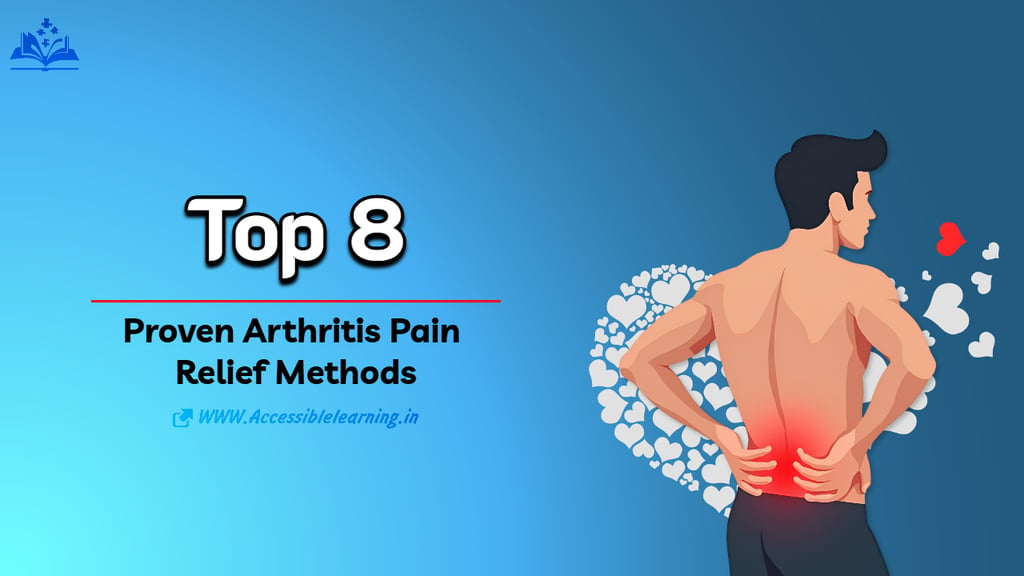
Top 8 Proven Arthritis Pain Relief Methods: What Really Works
Discover the most effective pain relief methods for arthritis, from medications and physical therapy to natural remedies and innovative treatments. Learn what works best for your joints.
MODERN DISEASESHEALTH/DISEASENEW YOUTH ISSUESGLOBAL ISSUESA LEARNING
Sachin K Chaurasiya
5/3/20255 min read


Arthritis is more than just joint pain—it’s a persistent companion for over 350 million people worldwide, often disrupting daily activities, sleep, and mental well-being. While there is no cure yet, managing the pain effectively can dramatically improve quality of life. But with so many pain relief options available, how do you know which one truly works?
In this in-depth guide, we’ll walk you through various arthritis pain relief methods—from conventional medications to lifestyle interventions and emerging therapies. Whether you're newly diagnosed or seeking better relief, understanding your options can help you make informed decisions.
Over-the-Counter (OTC) Medications
OTC options offer quick and accessible relief for mild to moderate arthritis pain.
Pros
Easy accessibility
Fast relief for mild to moderate pain
Can be combined with other treatments
Cons
Long-term use risks (e.g., stomach issues, liver damage)
Common options
NSAIDs (Nonsteroidal anti-inflammatory drugs): Ibuprofen (Advil), Naproxen (Aleve)
→ Reduces inflammation and painAcetaminophen (Tylenol): Less anti-inflammatory action but suitable for those who can't take NSAIDs
Best for: Occasional flares, early-stage arthritis
Did you know? A 2019 study from the American College of Rheumatology found that regular NSAID use helped reduce joint stiffness by up to 35% in osteoarthritis patients.
Prescription Medications
When OTCs are not enough, doctors step in with heavier artillery.
Key options
Corticosteroids: Strong inflammation reducers (e.g., Prednisone)
DMARDs (Disease-Modifying Anti-Rheumatic Drugs): Like Methotrexate, they slow disease progression
Biologics: Highly targeted treatments like Humira or Enbrel, especially effective for autoimmune arthritis.
Pros
Treat the disease itself, not just symptoms
Can dramatically improve quality of life
Cons
Possible side effects (e.g., immune suppression)
High costs without insurance support
Best for: Rheumatoid arthritis, psoriatic arthritis, and moderate to severe cases.
Interesting Insight: Biologics are derived from living cells — truly representing a new frontier in arthritis treatment.
Topical Treatments
Rub it in; feel the difference.
Topical options deliver direct relief to painful joints.
Examples
Capsaicin Cream: Uses chili pepper extract to block pain signals.
Diclofenac Gel: A topical NSAID that penetrates joints without systemic side effects.
Pros
Minimal systemic exposure
Effective for smaller, accessible joints (like hands and knees)
Cons
Needs consistent reapplication
Less effective for deep joint pain
Best for: Hand and knee arthritis.
Fun Fact: Capsaicin works by depleting substance P, a chemical that sends pain signals to your brain.


Physical Therapy and Exercise
Motion is lotion for your joints.
Targeted movement and therapy strengthen muscles and keep joints flexible.
Effective exercises
Water aerobics
Gentle yoga or Tai Chi
Low-impact strength training
Pros
Enhances mobility naturally
Boosts overall health with no medication
Cons
Requires consistency and patience
Might be tough during active flare-ups
Best for: Anyone with arthritis — prevention and management alike.
Motivational Stat: 150 minutes of moderate exercise per week can slash arthritis symptoms by nearly 40%!
Dietary Changes and Supplements
Healing from the inside out.
What you put on your plate can either inflame or soothe your joints.
Anti-inflammatory foods
Omega-3-rich foods (like walnuts and flaxseeds)
Dark leafy greens, berries, turmeric, and ginger
Key supplements
Glucosamine & Chondroitin: May protect cartilage
Omega-3s: Natural inflammation fighters
Vitamin D: Supports joint and bone health
Pros
Natural, long-term strategy
Improves overall well-being
Cons
Results are gradual, not instant
Supplements vary in quality — choose wisely
Best for: Long-term arthritis management and boosting joint health.
Science Says: Curcumin (found in turmeric) was shown to match ibuprofen's effectiveness for knee arthritis pain in a clinical study!
Heat and Cold Therapy
Old-school remedy, real-world results.
Switching between hot and cold treatments can work wonders for pain and swelling.
How it helps
Heat: Relaxes muscles and eases stiffness.
Cold: Numbs sharp pain and reduces inflammation.
Pros
Instant comfort
Zero cost if done at home
Cons
Temporary fix
Not a cure — more of a daily aid
Best for: Quick pre-activity prep or post-activity recovery.
Expert Tip: Alternate heat and cold in short bursts for maximum benefit (5 minutes cold, 10 minutes heat).
Alternative Therapies
Thinking outside the medicine cabinet.
Many find relief through holistic and complementary approaches.
Popular options
Acupuncture: Targets pain pathways through strategic needle placement.
Massage therapy: Improves circulation and eases muscle tension.
Mindfulness meditation: Reduces the brain’s perception of pain.
Pros
Enhances overall relaxation
Few or no side effects
Cons
Not universally effective
Some therapies can be costly
Best for: People seeking natural stress and pain relief combinations.
Brain Booster: Meditation can rewire your brain to process pain less intensely!


Injections and Surgery
When conservative methods fall short.
Injections
Steroid shots: Rapid inflammation relief
Hyaluronic acid injections: Improve joint lubrication
Surgical options
Joint replacement (knee, hip): Life-changing for advanced arthritis
Arthroscopic surgery: Minimally invasive procedures to clean joints
Pros
Restores major function
Provides long-term or even permanent relief
Cons
Surgery involves recovery risks
Not suitable for everyone
Best for: Severe arthritis that severely limits daily activities.
Hopeful Fact: Knee replacements boast a 90–95% success rate, often lasting 20+ years!
FAQs
What is the best pain relief for arthritis?
There’s no single “best” option. Many people find success with a combination of treatments like OTC medications, exercise, dietary changes, and sometimes prescription drugs. What works best depends on the type of arthritis you have and how severe it is.
Are natural remedies effective for arthritis pain?
Yes, natural remedies like turmeric, omega-3 supplements, and gentle exercises (like yoga or swimming) can significantly ease arthritis symptoms for some people. However, they often work best when combined with other treatments and consistency.
Is exercise safe if I have arthritis?
Absolutely! Regular, low-impact exercise helps strengthen muscles around joints, improves flexibility, and reduces pain. Just be sure to choose joint-friendly activities and consult a physical therapist if needed.
When should I consider seeing a specialist for arthritis?
If OTC medications, lifestyle changes, and home treatments aren’t providing enough relief—or if your joints are swelling, deforming, or severely limiting your daily activities—it’s time to see a rheumatologist or orthopedic specialist.
Can diet really impact arthritis symptoms?
Yes! An anti-inflammatory diet rich in fruits, vegetables, omega-3s, and whole grains can help lower inflammation and ease arthritis symptoms. Processed foods, sugar, and excessive red meat might worsen them.
Are arthritis medications safe for long-term use?
Some are, but many (especially NSAIDs and corticosteroids) can have side effects with long-term use. It’s important to work closely with your doctor to monitor for any issues and explore other therapies to minimize risks.
Can arthritis pain completely go away?
While arthritis is usually a lifelong condition, many people achieve long periods of minimal or no pain through effective management strategies. The goal is often to reduce flare-ups and improve function, even if occasional symptoms persist.
How to Choose the Right Pain Relief Strategy
Arthritis treatment is personal.
What works wonders for someone else might not suit you. It’s a journey, not a race.
Pro Tip: Keep a pain diary — log your activities, meals, treatments, and pain levels daily. Patterns often reveal themselves, helping you and your doctor customize your plan.
Encouragement: Every small step toward pain relief is a major victory toward regaining your vibrant life.
Managing arthritis pain is an evolving process. Modern medicine, natural remedies, and mindful practices offer a powerful, diverse toolkit for patients today. By staying informed and proactive, you can go beyond just "managing" arthritis — you can thrive despite it.
You deserve a life filled with movement, joy, and hope. And with the right strategies, that life is absolutely within reach.
Subscribe to our newsletter
All © Copyright reserved by Accessible-Learning
| Terms & Conditions
Knowledge is power. Learn with Us. 📚


